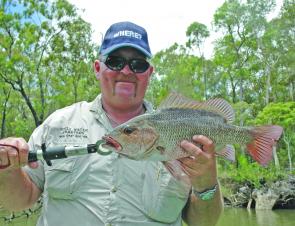The holiday crowds are gone and now it’s time to get serious! February is usually a hot time to go fishing so we need to make sure we’re well prepared.
It’s no secret that Queenslanders are on the front line when it comes to the sun’s harmful rays. It’s not rocket science that the hotter it is, the more water you need to drink. I suggest freezing a couple of water bottles and grabbing them before you head out on the water.
If you take your family fishing, the time spent fishing will depend on the kids’ comfort. We take a large umbrella, have plenty of breaks and look for shade when we can. Kids are also dehydrate faster than adults so it is very important to keep their fluids up. I like to take a trigger sprayer full of freshwater, it keeps the kids cool and is fun.
First aid boxes have come along way in the last few years and most fishing and boating stores stock simple kits that can help you survive the odd cut and bruise but I have added a few items to my kit. As a mad keen lurefisher I have had and have put a few lures into the odd human (I usually fish with barbless hooks though!). A spray can of anaesthetic, scalpel and strong pain killers are handy items to have for removing hooks when you’re hours away from the nearest road. Throw in a sun shirt, a wide brimmed hat and plenty of sunscreen and you will be better prepared for the next month.
February is the time to start looking for cooler water, especially if you’re fishing the smaller creeks. Creeks like Theodolite, Coonar and Moore Park will start to get too hot during the day, driving fish out of the systems in search of more comfortable water temperatures. The best time to fish these smaller creeks is early in the morning or late into the night.
Bigger systems will still have hot water in the shallows on the high tide before meeting the deeper, cooler water at low tide. The trick is to watch your sounder and trying to move with the cooler water as it drains with the tide. The fish may not move with it but as the more comfortable water passes through, stationary fish may start feeding.
In dams the wind will play a major role in pushing the surface water around and moving the heated water around, so it pays to watch the wind direction and your sounder.
What’s going to be the key to good fish holding snags over the peak of summer? Shade. When I’m lurefishing during the heat of the day I have always found that the structure with the most shade holds the most fish and the most active fish. So, when you are cruising up a river deciding which bank of the river to cast at pick the side with the most shade – the fish will have.
Reads: 850
Brett Jones with a jack caught jigging in the deeper, cooler water of the Baffle.




